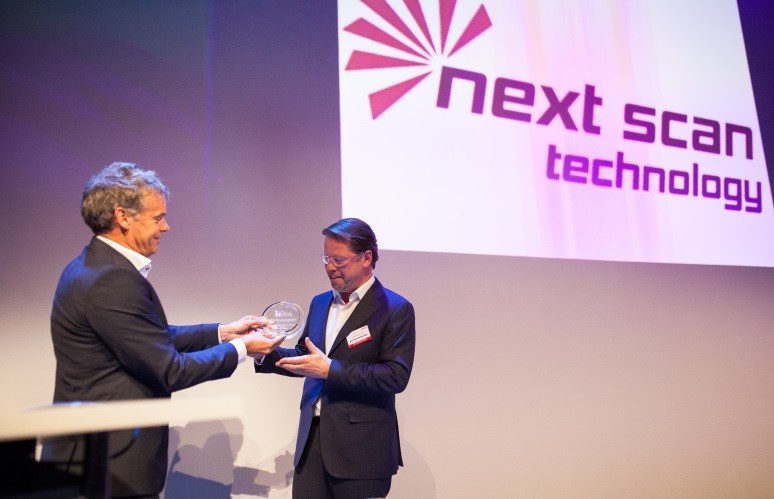Founders of Next Scan Technology Receive EPIC Phoenix Award 2017

EPIC president Benno Oderkerk presents the EPIC Phoenix Award 2017 to Lars Penning and Ronny De Loor of Next Scan Technology. The award was presented on 6 April during the EPIC's annual general meeting in Eindhoven, The Netherlands, recognising entrepreneurship in photonics.
"Myself and Ronny De Loor are really proud to receive this EPIC Phoenix award. For us, it is an honour and recognition to be elected by such a remarkable group of European entrepreneurs in photonics. From the very beginning, we believed in the opportunity to address an uncharted area in laser material processing. Since timing determines the necessity of an enabling technology, we are encouraged and convinced that we grow with our partner SCANLAB addressing the markets of the future and make further contribution to the EPIC community." said Lars Penning, CEO and Co-Founder of Next Scan Technology, after being presented with the prestigious award.
Back in 2006 I ran into a laser company offering large format laser cutter and engraving systems. With the idea of being able to materialise own designs, the company's manager gave the possibility to work with this equipment in weekends off. To explore the business potential of production services for the creative industry, I decided to buy a system. After discussing raising the mortgage with my wife, I cleaned out the garage and moved in a large footprint laser machine. With my day to day job as sales manager of an engineering company, I spend my free time in the weekends and nights on laser cutting and engraving of different materials. I started with processing decorative plastics, engraving of wine boxes and ended up with welding and cutting medical devices. However, throughput wise it was a challenge to make a profit with this expensive machine, so I questioned and challenged myself on how to improve performance"¦
My friend Ronny De Loor mastered high throughput laser scanning during his career in Graphic Arts. With some of his designs based on polygon scanning and tacit knowledge on fast scanning I asked him, "Can't we develop a polygon scanner for CO2 lasers"? It wasn't that easy. Beside the substantial resources required for engineering and prototyping, there was a challenge on the modulation performance of high power lasers. For fast scanning the laser requires pulse frequencies in the Megahertz range where state-of-the-art was 100 kHz"¦
But things changed in 2009. As an engineering service we showcased some scanners at the LASER World of PHOTONICS exhibition in Munich. With its different optical architecture and high performance, we got interesting questions from leading research organisations, renowned system integrators, and laser manufacturers. We found out that the laser material industry was interested in higher scanning speeds to unlock the potential of high powered ultrafast pulsed lasers"¦
After leaving the engineering company, I focused full time on market research and business modelling where Ronny converted market requirements into a product solution. With a unique scanner concept Ronny and I founded Next Scan Technology in 2010. With personal investments, loans, and allocating available free time of the engineers, a demonstrator with innovative mirror optics was developed and introduced at the 2011 edition of LASER World of PHOTONICS in Munich. The interest was overwhelming, leaving us no other option than to get the industrial product development funded. A lead user fuelled our prototype development and were able to launch the product at the 2013 Munich show. From that moment, we received interest from system integrators in Asia and received our first orders. Validation projects were initiated and new requirements were materialising. However, it was a challenge to convert R&D related projects into a stable cash flow.
Cashflow management required to offer engineering services on the side, however, if we wanted to enter the next level, we needed to focus our efforts full time on the scanner business. With the market potential in Asia we faced the challenge of professionalising the organisation. We needed to find a strategic partner offering credibility and funding of required investments besides input on lessons learned in this challenging industry. End 2015 Next Scan Technology was acquired by SCANLAB. By teaming up with the market leader we are ready to continuously provide innovative and distinctive products that offer competitive edge to our customers.
"The EPIC Phoenix award symbolises the innovative entrepreneurship, that eventually leads to success stories of innovative European Photonics Companies" says Benno Oderkerk, CEO of Avantes in The Netherlands, and president of the board of directors of EPIC.
































